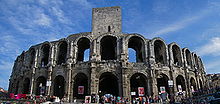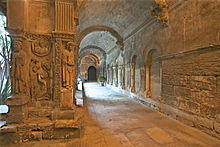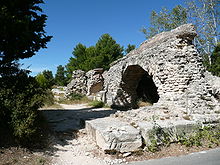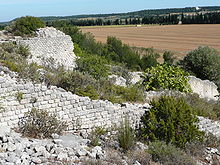- Arles
-
This article is about the city in France. For the medieval kingdom, see Kingdom of Arles. For the village in Ireland, see Arless. For the village in England, see Arle, Gloucestershire.
Arles
Left bank of the Rhône in Arles 
Administration Country France Region Provence-Alpes-Côte d'Azur Department Bouches-du-Rhône Arrondissement Arles Canton Arles-Est and Arles-Ouest Intercommunality Arles-Crau-Camargue-Montagnette Mayor Hervé Schiavetti (PCF)
(2008–2014)Statistics Elevation 0–57 m (0–187 ft)
(avg. 10 m/33 ft)Land area1 758.93 km2 (293.02 sq mi) Population2 52,729 (2008) - Density 69 /km2 (180 /sq mi) INSEE/Postal code 13004/ 13200 1 French Land Register data, which excludes lakes, ponds, glaciers > 1 km² (0.386 sq mi or 247 acres) and river estuaries. 2 Population without double counting: residents of multiple communes (e.g., students and military personnel) only counted once. Coordinates: 43°40′36″N 4°37′40″E / 43.676650°N 4.627803°E
Arles (French pronunciation: [aʁl]; Occitan: Arle [ˈaʀle] in both classical and Mistralian norms) is a city and commune in the south of France, in the Bouches-du-Rhône department, of which it is a subprefecture, in the former province of Provence.
A large part of the Camargue is located on the territory of the commune, making it the largest commune in Metropolitan France in terms of territory (though Maripasoula, French Guiana is much larger). The city has a long history, and was of considerable importance in the Roman province of Gallia Narbonensis. The Roman and Romanesque Monuments of Arles were listed as UNESCO World Heritage Sites in 1981. The Dutch post-Impressionist painter Vincent van Gogh lived in Arles in 1888-1889 and produced over 300 paintings and drawings during his time there. An international photography festival has been held in the city since 1970.
Contents
Geography
The Rhône river forks into two branches just upstream of Arles, forming the Camargue delta. Because the Camargue is for a large part administratively part of Arles, the commune as a whole is the largest commune in Metropolitan France in terms of territory, although its population is only slightly more than 50,000. Its area is 758.93 km2 (293.02 sq mi), which is more than seven times the area of Paris.
History
Ancient era
The Ligurians were in this area from about 800 BC. Later Celtic influences have been discovered. The city became an important Phoenician trading port, before being taken by the Romans.
The Romans took the town in 123 BC and expanded it into an important city, with a canal link to the Mediterranean Sea being constructed in 104 BC. However, it struggled to escape the shadow of Massalia (Marseilles) further along the coast.
Its chance came when it sided with Julius Caesar against Pompey, providing military support. Massalia backed Pompey; when Caesar emerged victorious, Massalia was stripped of its possessions, which were transferred to Arelate as a reward. The town was formally established as a colony for veterans of the Roman legion Legio VI Ferrata, which had its base there. Its full title as a colony was Colonia Iulia Paterna Arelatensium Sextanorum, "the ancestral Julian colony of Arles of the soldiers of the Sixth."
Arelate was a city of considerable importance in the province of Gallia Narbonensis. It covered an area of some 99 acres (400,000 m²) and possessed a number of monuments, including an amphitheatre, triumphal arch, Roman circus, theatre, and a full circuit of walls. Ancient Arles was closer to the sea than it is now and served as a major port. It also had (and still has) the southernmost bridge on the Rhone. Very unusually, the Roman bridge was not fixed but consisted of a pontoon-style bridge of boats, with towers and drawbridges at each end. The boats were secured in place by anchors and were tethered to twin towers built just upstream of the bridge. This unusual design was a way of coping with the river's frequent violent floods, which would have made short work of a conventional bridge. Nothing now remains of the Roman bridge, which has been replaced by a more modern bridge near the same spot.
The city reached a peak of influence during the 4th and 5th centuries, when Roman Emperors frequently used it as their headquarters during military campaigns. In 395 it became the seat of the Praetorian Prefecture of the Gauls, governing the western part of the Western Empire: Gaul proper plus Hispania (Spain) and Armorica (Brittany).
It became a favorite city of Emperor Constantine I, who built baths there, substantial remains of which are still standing. His son, Constantine II, was born in Arles. Usurper Constantine III declared himself emperor in the West (407–411) and made Arles his capital in 408.
Arles became renowned as a cultural and religious centre during the late Roman Empire. It was the birthplace of the sceptical philosopher Favorinus. It was also a key location for Roman Christianity and an important base for the Christianization of Gaul. The city's bishopric was held by a series of outstanding clerics, beginning with Saint Trophimus around 225 and continuing with Saint Honoré, then Saint Hilary in the first half of the 5th century. The political tension between the Catholic bishops of Arles and the Visigothic kings is epitomized in the career of the Frankish St Caesarius, bishop of Arles 503–542, who was suspected by the Arian Visigoth Alaric II of conspiring with the Burgundians to turn over the Arelate to Burgundy, and was exiled for a year to Bordeaux in Aquitaine, and again in 512 when Arles held out against Theodoric the Great, Caesarius was imprisoned and sent to Ravenna to explain his actions before the Ostrogothic king.[1]
The friction between the Arian Christianity of the Visigoths and the Catholicism of the bishops sent out from Rome established deep roots for religious heterodoxy, even heresy, in Occitan culture. At Treves in 385, Priscillian achieved the distinction of becoming the first Christian burned alive for heresy (Manichaean in his case, see also Cathars, Camisards). Despite this tension and the city's decline in the face of barbarian invasions, Arles remained a great religious centre and host of church councils (see Council of Arles), the rival of Vienne, for hundreds of years.
Roman aqueduct and mill
The Barbegal aqueduct and mill is a Roman watermill complex located on the territory of the commune of Fontvieille, a few kilometres from Arles. The complex has been referred to as "the greatest known concentration of mechanical power in the ancient world".[2] The remains of the mill streams and buildings which housed the overshot water wheels are still visible at the site, and it is by far the best preserved of ancient mills. There are two aqueducts which join just north of the mill complex, and a sluice which enabled the operators to control the water supply to the complex. The mill consisted of 16 waterwheels in two separate rows built into a steep hillside. There are substantial masonry remains of the water channels and foundations of the individual mills, together with a staircase rising up the hill upon which the mills are built. The mills apparently operated from the end of the 1st century until about the end of the 3rd century.[3] The capacity of the mills has been estimated at 4.5 tons of flour per day, sufficient to supply enough bread for the 6,000 of 30-40,000 inhabitants of Arelate at that time.[4] Another similar mill complex existed also on the Janiculum in Rome. Examination of the mill leat still just visible on one side of the hill shows a substantial accretion of lime in the channel, tending to confirm its long working life.
It is thought that the wheels were overshot water wheels with the outflow from the top driving the next one down and so on, to the base of the hill. Vertical water mills were well known to the Romans, being described by Vitruvius in his De Architectura of 25 BC, and mentioned by Pliny the Elder in his Naturalis Historia of 77 AD. There are also later references to floating water mills from Byzantium and to sawmills on the river Moselle by the poet Ausonius. The use of multiple stacked sequences of reverse overshot water-wheels was widespread in Roman mines.
Middle Ages
Arles was badly affected by the invasion of Provence by the Muslim Saracens and the Franks, who took control of the region in the 8th century. In 855 it was made the capital of a Frankish Kingdom of Arles, which included Burgundy and part of Provence, but was frequently terrorised by Saracen and Viking raiders. In 888, Rudolph, Count of Auxerre (now in north-western Burgundy), founded the kingdom of Transjuran Burgundy (literally, beyond the Jura mountains), which included western Switzerland as far as the river Reuss, Valais, Geneva, Chablais and Bugey.
In 933, Hugh of Arles ("Hugues de Provence") gave his kingdom up to Rudolph II, who merged the two kingdoms into a new Kingdom of Arles. In 1032, King Rudolph III died, and the Kingdom was inherited by Emperor Conrad II the Salic. Though his successors counted themselves kings of Arles, few went to be crowned in the cathedral. Most of the territory of the Kingdom was progressively incorporated into France. During these troubled times, the amphitheatre was converted into a fortress, with watchtowers built at each of the four quadrants and a minuscule walled town being constructed within. The population was by now only a fraction of what it had been in Roman times, with much of old Arles lying in ruins.
The town regained political and economic prominence in the 12th century, with the Holy Roman Emperor Frederick Barbarossa traveling there in 1178 for his coronation. In the 12th century, it became a free city governed by an elected podestat (chief magistrate; literally "power"), who appointed the consuls and other magistrates. It retained this status until the French Revolution of 1789.
Arles joined the countship of Provence in 1239 but suffered its prominence being eclipsed once more by Marseilles. In 1378, the Holy Roman Emperor Charles IV ceded the remnants of the Kingdom of Arles to the Dauphin of France (later King Charles VI of France) and the Kingdom ceased to exist even on paper.
Modern era
Arles remained economically important for many years as a major port on the Rhône. The arrival of the railway in the 19th century eventually killed off much of the river trade, leading to the town becoming something of a backwater.
This made it an attractive destination for the painter Vincent van Gogh, who arrived there on 21 February 1888. He was fascinated by the Provençal landscapes, producing over 300 paintings and drawings during his time in Arles. Many of his most famous paintings were completed there, including The Night Cafe, the Yellow Room, Starry Night Over the Rhone, and L'Arlésienne. Paul Gauguin visited van Gogh in Arles. However, van Gogh's mental health deteriorated and he became alarmingly eccentric, culminating in the infamous ear-severing incident in December 1888 which resulted in two stays in the Old Hospital of Arles. The concerned Arlesians circulated a petition the following February demanding that van Gogh be confined. In May 1889 he took the hint and left Arles for the Saint-Paul asylum at nearby Saint-Rémy-de-Provence.
Population
Historical population of Arles 1806 1820 1831 1836 1841 1846 1851 1856 1861 1866 20,151 20,150 20,236 20,048 20,460 23,101 23,208 24,816 25,543 26,367 1816 1872 1881 1891 1896 1901 1906 1911 1921 1926 25,095 24,695 23,480 24,288 24,567 28,116 31,010 31,014 29,146 32,485 1946 1954 1962 1968 1975 1982 1990 1999 2008 35,017 37,443 41,932 45,774 50,059 50,500 52,058 50,426 52,729 Main sights
 Capital of column in St. Trophime cloister.
Capital of column in St. Trophime cloister. See also: Arles, Roman and Romanesque Monuments
See also: Arles, Roman and Romanesque MonumentsArles has important remains of Roman times, which have been listed as World Heritage Sites since 1981. They include:
- The Roman theatre
- The arena or amphitheatre
- The Alyscamps (Roman necropolis)
- The Thermes of Constantine
- The cryptoporticus
- Arles Obelisk
- Barbegal aqueduct and mill
The Church of St. Trophime (Saint Trophimus), formerly a cathedral, is a major work of Romanesque architecture, and the representation of the Last Judgment on its portal is considered one of the finest examples of Romanesque sculpture, as are the columns in the adjacent cloister.
The town also has an outstanding museum of ancient history, the Musée de l'Arles et de la Provence antiques, with one of the best collections of Roman sarcophagi to be found anywhere outside Rome itself. Another museum is the Museon Arlaten.
The courtyard of the Old Arles hospital, now named "Espace Van Gogh," is a center for Vincent van Gogh's works, several of which are masterpieces.[5] The garden, framed on all four sides by buildings of the complex, is approached through arcades on the first floor. A circulation gallery is located on the first and second floors.[6]
Archaeology
In September–October 2007 divers led by Luc Long from the French Department of Subaquatic Archaeological Research, headed by Michel L'Hour, discovered a life-sized marble bust of an apparently important Roman person in the Rhone River near Arles, together with smaller statues of Marsyas in Hellenistic style and of the god Neptune from the third century AD. The larger bust was tentatively dated to 46 BC. Since the bust displayed several characteristics of an ageing person with wrinkles, deep naso-labial creases and hollows in his face, and since the archaeologists believed that Julius Caesar had founded the colony Colonia Iulia Paterna Arelate Sextanorum in 46 BC, the scientists came to the preliminary conclusion that the bust depicted a life-portrait of the Roman dictator: France's Minister of Culture Christine Albanel reported on May 13, 2008, that the bust would be the oldest representation of Caesar known today.[7] The story was picked up by all larger media outlets.[8][9] The realism of the portrait was said to place it in the tradition of late Republican portrait and genre sculptures. The archaeologists further claimed that a bust of Julius Caesar might have been thrown away or discreetly disposed of, because Caesar's portraits could have been viewed as politically dangerous possessions after the dictator's assassination.
Historians and archaeologists not affiliated with the French administration, among them the renowned archaeologist and expert on Caesar and Augustus Paul Zanker, were quick to question whether the bust is a portrait of Caesar.[10][11][12] Many noted the lack of resemblances to Caesar's likenesses issued on coins during the last years of the dictator's life, and to the Tusculum bust of Caesar,[13] which depicts Julius Caesar in his lifetime, either as a so-called zeitgesicht or as a direct portrait. After a further stylistic assessment Zanker dated the Arles-bust to the Augustan period. Elkins argued for the third century AD as the terminus post quem for the deposition of the statues, refuting the claim that the bust was thrown away due to feared repercussions from Caesar's assassination in 44 BC.[14] The main argument by the French archaeologists that Caesar had founded the colony in 46 BC proved to be incorrect, as the colony was founded by Caesar's former quaestor Tiberius Claudius Nero on the dictator's orders in his absence.[15] Mary Beard has accused the persons involved in the find to have willfully invented their claims for publicity reasons. The French ministry of culture has not yet responded to the criticism and negative reviews.
Sport
AC Arles-Avignon is a professional French football team. They compete in Ligue 1, having gained promotion from Ligue 2 in the 2009-2010 season. They play at the Parc des Sports, which has a capacity of just over 17,000.
Culture
A well known photography festival, Rencontres d'Arles, takes place in Arles every year, and the French national school of photography is located there.
The major French publishing house Actes Sud is also situated in Arles.
Bull fights are conducted in the amphitheatre, including Provençal-style bullfights (courses camarguaises) in which the bull is not killed but rather a team of athletic men attempt to remove a tassle from the bull's horn without getting injured. Every Easter and on the first weekend of September, Arles also holds Spanish-style corridas (in which the bulls are killed) with an encierro (bull-running in the streets) preceding each fight.
The film Ronin was partially filmed in Arles.
Economy
Arles's open-air street market is a major market in the region. It occurs on Saturday and Wednesday mornings.
Transport
The Gare d'Arles railway station offers connections to Avignon, Nîmes, Marseilles, Paris, Bordeaux and several regional destinations.
Notable people
- The Provençal poet Frédéric Mistral (1830–1914) was born near Arles.
- Jeanne Calment (1875–1997), the oldest human being whose age is documented, was born, lived and died, at the age of 122 years and 164 days, in Arles
- Anne-Marie David, singer (Eurovision winner in 1973)
- Christian Lacroix, fashion designer, was born in Arles. He is well known in the gay community.
- Lucien Clergue, photographer
- Djibril Cissé, footballer for Panathinaikos F.C. and France
- Genesius of Arles, a notary martyred under Maximianus in 303 or 308.
- Blessed Jean Marie du Lau, last Archbishop of Arles, killed by the revolutionary mob in Paris on September, 2 1792
- Juan Bautista, matador
- Mehdi Savalli, matador
- The medieval writer Antoine de la Sale was probably born in Arles around 1386
- Home of the Gipsy Kings, a music group from Arles
- Gael Givet footballer for Blackburn Rovers
- Vincent van Gogh, lived there for quite some time in the early years of his life time, he later would go on to cut off his ear in a brothel.
- Fanny Valette, actress.
Twin towns — sister cities
Arles is twinned with:
 Pskov, Russia
Pskov, Russia Jerez de la Frontera, Spain
Jerez de la Frontera, Spain Fulda, Germany
Fulda, Germany York, Pennsylvania, United States
York, Pennsylvania, United States Cubelles, Spain
Cubelles, Spain Vercelli, Italy
Vercelli, Italy Sagné, Mauritania
Sagné, Mauritania Kalymnos, Greece
Kalymnos, Greece Wisbech, United Kingdom
Wisbech, United Kingdom Zhouzhuang, Kunshan, Jiangsu, People's Republic of China
Zhouzhuang, Kunshan, Jiangsu, People's Republic of China Verviers, Belgium
Verviers, Belgium
See also
- Archbishopric of Arles
- Montmajour Abbey
- Trinquetaille
- Langlois Bridge
- Saint-Martin-de-Crau
- Communes of the Bouches-du-Rhône department
References
 This article incorporates text from a publication now in the public domain: Herbermann, Charles, ed (1913). "Archdiocese of Aix". Catholic Encyclopedia. Robert Appleton Company.
This article incorporates text from a publication now in the public domain: Herbermann, Charles, ed (1913). "Archdiocese of Aix". Catholic Encyclopedia. Robert Appleton Company.- INSEE
- ^ Wace, Dictionary)
- ^ Kevin Greene, "Technological Innovation and Economic Progress in the Ancient World: M.I. Finley Re-Considered", The Economic History Review, New Series, Vol. 53, No. 1. (Feb., 2000), pp. 29-59 (39)
- ^ Ville d'Histoire et de Patrimoine
- ^ La meunerie de Barbegal
- ^ Fisher, R, ed (2011). Fodor's France 2011. Toronto and New York: Fodor's Travel, division of Random House. p. 563 ISBN 978-1-4000-0473-7.
- ^ "Espace Van Gogh". Visiter, Places of Interest. Arles Office de Tourisme. Retrieved 2011-04-29.
- ^ Original communique (May 13, 2008); second communique (May 20, 2008); report (May 20, 2008)
- ^ E.g. "Divers find marble bust of Caesar that may date to 46 B.C.", CNN-Online et al.
- ^ Video (QuickTime) on the archaeological find (France 3)
- ^ Paul Zanker, "Der Echte war energischer, distanzierter, ironischer", Sueddeutsche Zeitung, May 25, 2008, on-line
- ^ Mary Beard, "The face of Julius Caesar? Come off it!", TLS, May 14, 2008, on-line
- ^ Nathan T. Elkins, 'Oldest Bust' of Julius Caesar found in France?, May 14, 2008, on-line
- ^ Cp. this image at the AERIA library
- ^ A different approach was presented by Mary Beard in that members of a military Caesarian colony would not have discarded portraits of Caesar, whom they worshipped as god, although statues were in fact destroyed by the Anti-Caesarians in the city of Rome after Caesar's assassination (Appian, BC III.1.9).
- ^ Konrat Ziegler & Walther Sontheimer (eds.), "Arelate", in Der Kleine Pauly: Lexikon der Antike, Vol. 1, col. 525, Munich 1979; in 46 BC Caesar himself was campaigning in Africa, before later returning to Rome.
External links
- Tourist office website
- Arles City Guide (English)
- Arles heritage website (French)
- Town council website (French)
- Early history
- Musée de l'Arles et de la Provence antiques
- The Complete Works of Van Gogh, Arles
- Photogallery of Arles
- Information and photos from ProvenceBeyond website
World Heritage Sites in France Île-de-France Palace and Park of Versailles · Palace of Fontainebleau and Park · Paris – Banks of the Seine · Provins · Routes of Santiago de Compostela1

Parisian basin Amiens Cathedral · Belfries of Belgium and France2 · Bourges Cathedral · Cathedral of Chartres · Cathedral of Notre-Dame, former Abbey of Saint-Remi and Palace of Tau, Reims · Cistercian Abbey of Fontenay · Fortifications of Vauban1 · Le Havre · Loire Valley between Sully-sur-Loire and Chalonnes1 · Mont Saint-Michel and its Bay1 · Routes of Santiago de Compostela1 · Vézelay Church and Hill
Nord-Pas-de-Calais East Fortifications of Vauban1 · Great Saltworks of Salins-les-Bains and Royal Saltworks of Arc-et-Senans · Place Stanislas, Place de la Carrière and Place d'Alliance, Nancy · Strasbourg – Grande Île · Prehistoric Pile dwellings around the Alps4
West Abbey Church of Saint-Savin-sur-Gartempe · Fortifications of Vauban1 · Loire Valley between Sully-sur-Loire and Chalonnes1 · Mont Saint-Michel and its Bay1 · Routes of Santiago de Compostela1
South West Albi · Bordeaux · Canal du Midi1 · Fortifications of Vauban1 · Prehistoric Sites and Decorated Caves of the Vézère Valley · Pyrénées - Mont Perdu3 · Routes of Santiago de Compostela1 · Saint-Émilion
Centre East Mediterranean Arles, Roman and Romanesque Monuments · Canal du Midi1 · Historic Fortified City of Carcassonne · Fortifications of Vauban1 · Gulf of Porto (Calanches de Piana • Gulf of Girolata • Scandola Reserve) · Papal Palace, Episcopal Ensemble and Avignon Bridge, Avignon · Pont du Gard · Roman Theatre and its Surroundings and Triumphal Arch of Orange · Routes of Santiago de Compostela1
Overseas departments
and territories1 Shared with other region/s · 2 Shared locally with other region/s and with Belgium · 3 Shared with Spain · 4 Shared with Austria, Germany, Italy, Slovenia and SwitzerlandCategories:- Arles
- Communes of Bouches-du-Rhône
Wikimedia Foundation. 2010.








